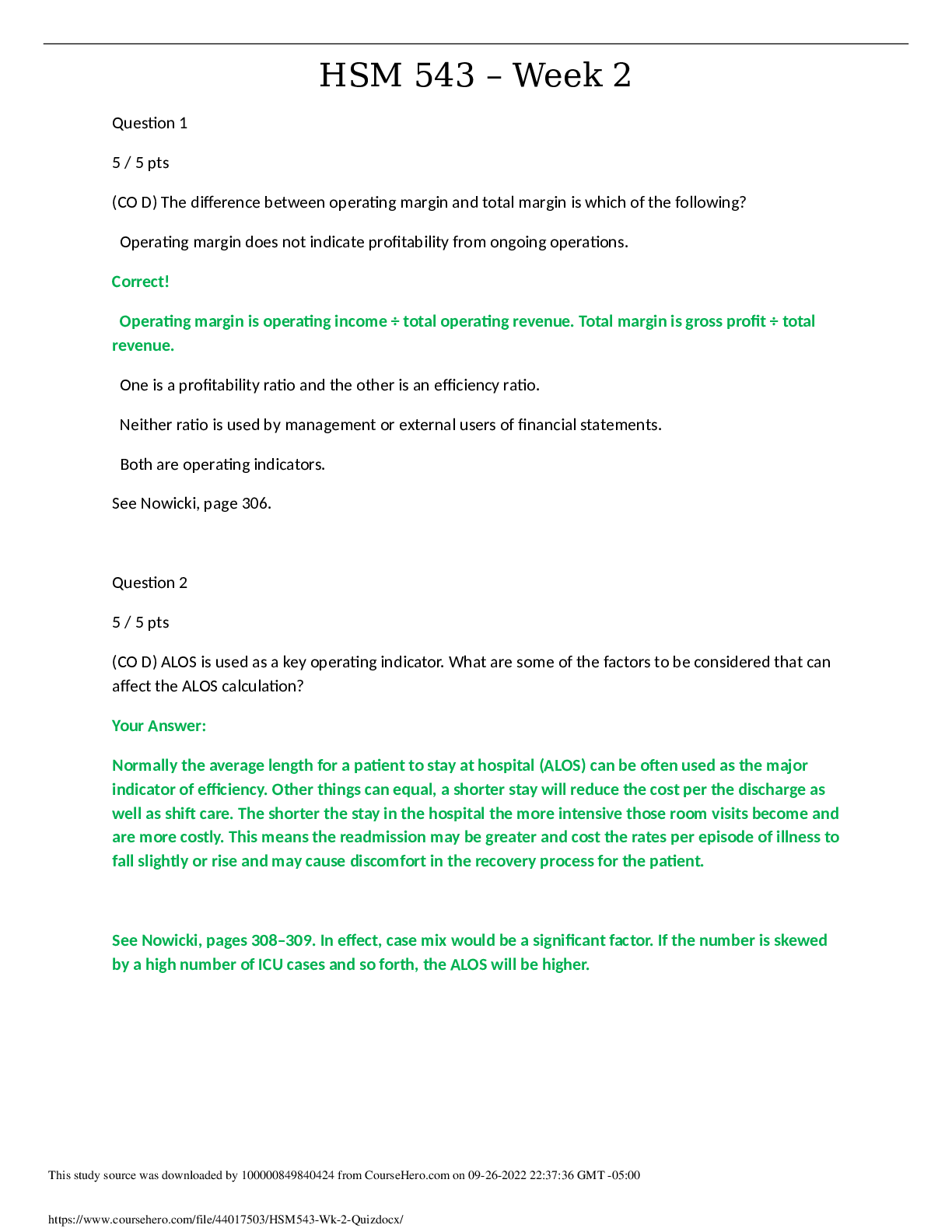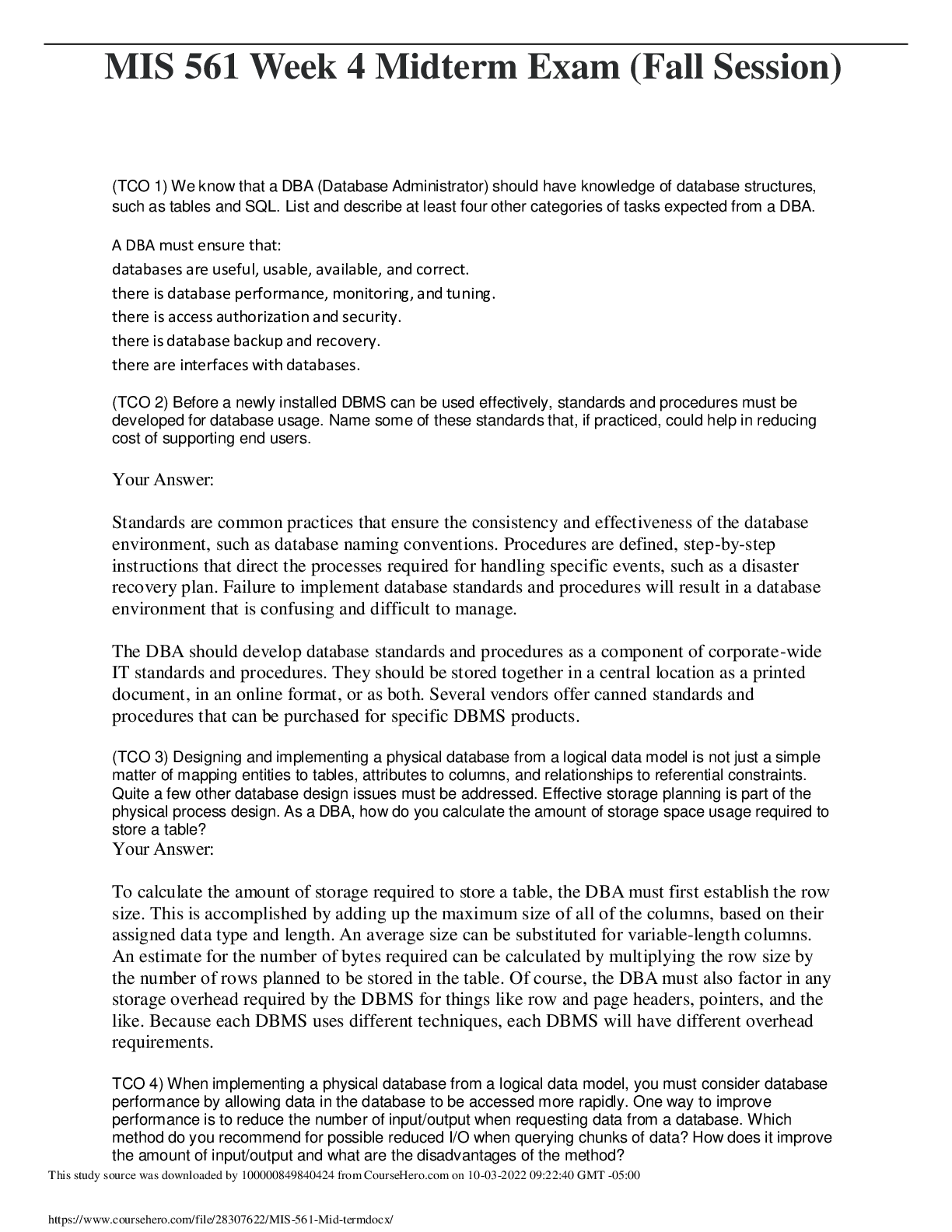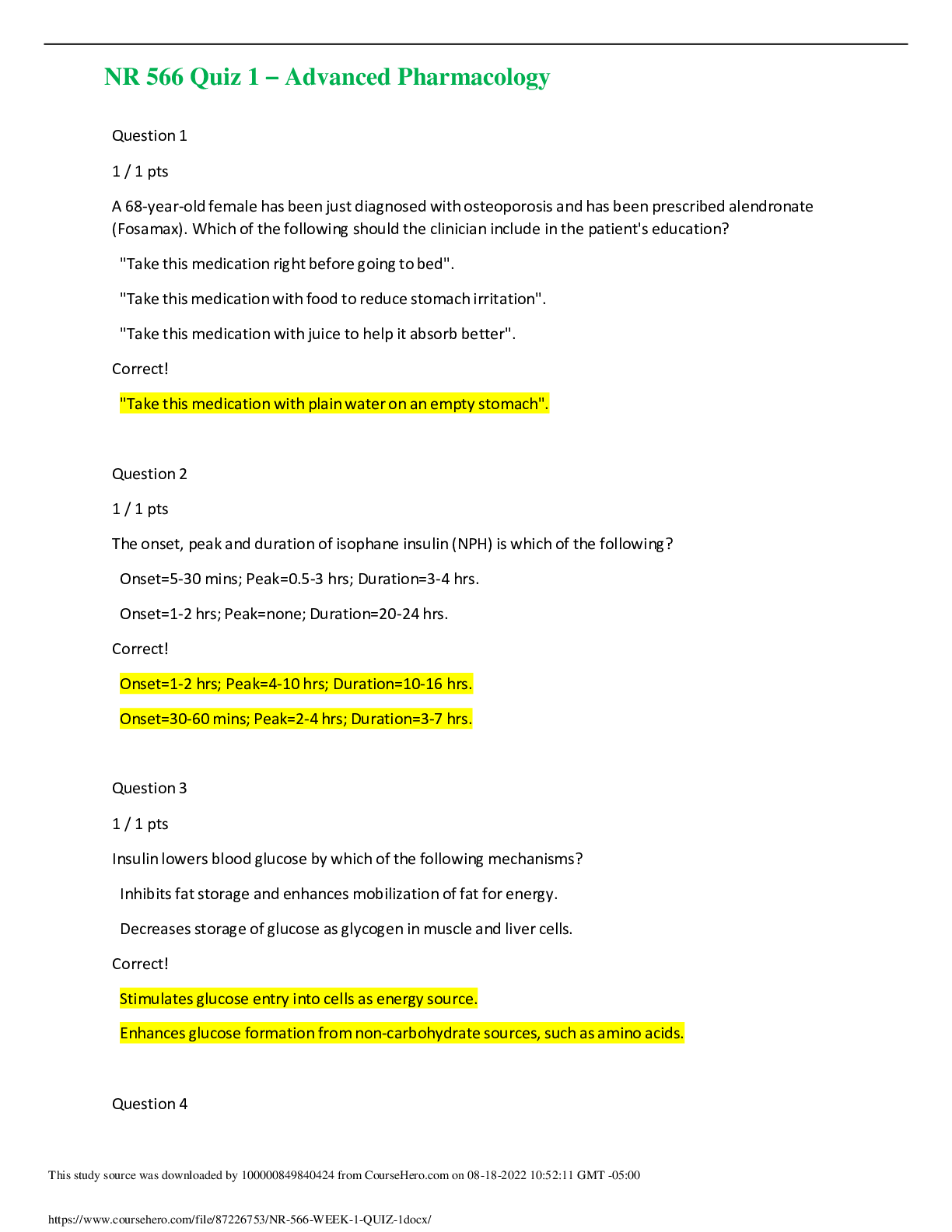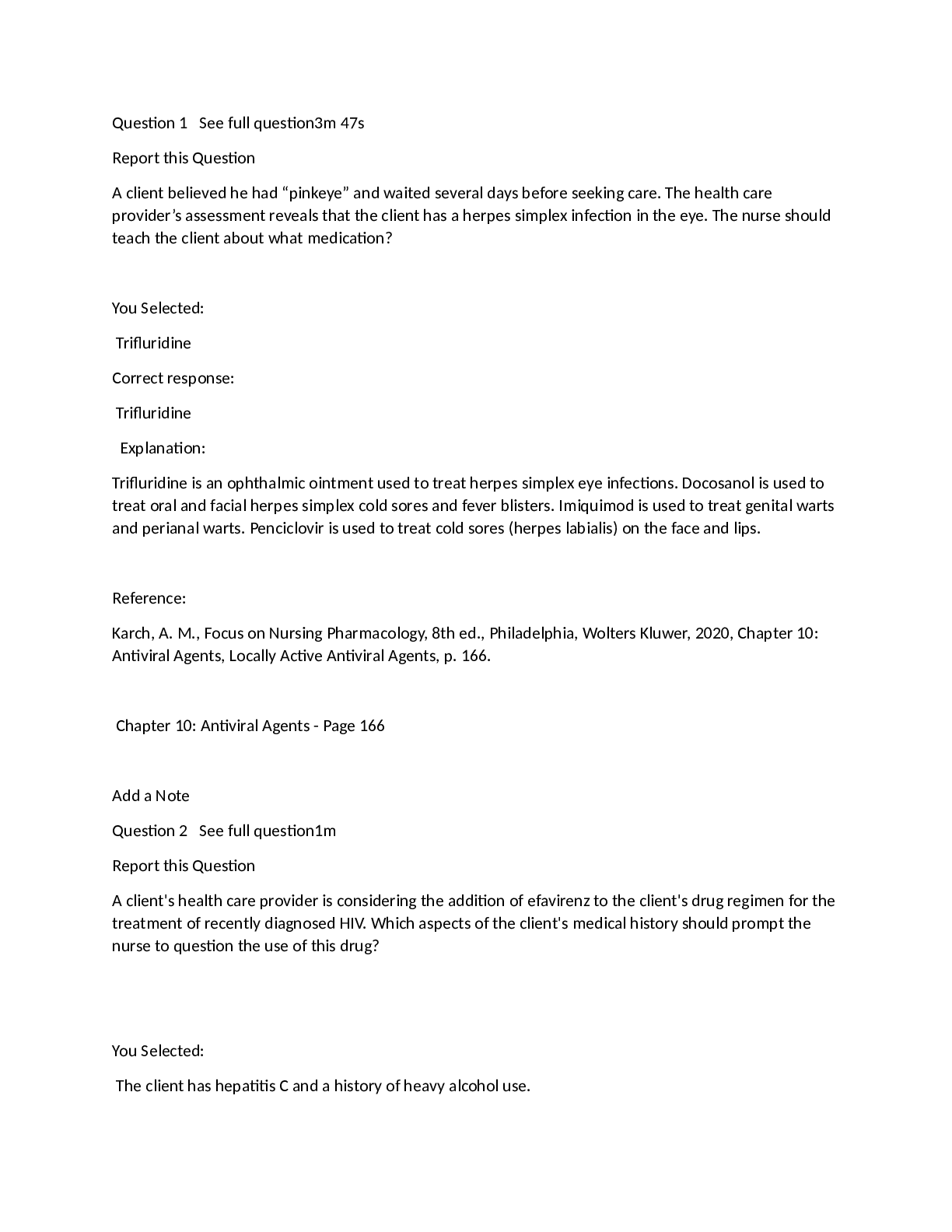*NURSING > EXAM > NR 511 Week 1 Quiz (GRADED A) Questions and Answer solutions | TOP SCORE PAPER (All)
NR 511 Week 1 Quiz (GRADED A) Questions and Answer solutions | TOP SCORE PAPER
Document Content and Description Below
NR 511 Week 1 Quiz Issues in Primary Care Question 1. Because of the potential for exploitation of older adults, the geriatric population is designated a vulnerable one when it comes to obtaining... informed consent for serving as a research subject. Safeguards you should adhere to when conducting research on a geriatric population include which of the following? Assessing the competence of the individual before obtaining consent. Question 2. If conflict arises during a job negotiation, you should consider: Separating the issue from the person. Question 3. Most health maintenance organizations (HMOs) use a reimbursement mechanism called capitation. This means that the: HMO reimburses the provider a predetermined fee per client per month based on the client’s age and sex. Question 4. Elder abuse and neglect are increasing concerns, and it is estimated that 4% to 10% of older Americans are abused or neglected. What is the legal responsibility of the health care provider in reporting elder abuse and neglect? The health care provider must report the suspected abuse or neglect to the appropriate state protective agency. Question 5. Relapse is a common phenomenon seen during behavioral changes. Useful strategies for the health care provider to institute to aid the client in a relapse situation include: Telling the client that the relapse is a learning opportunity in preparation for the next action stage. Question 6. Mrs. Smith, age 85, lost her husband 6 months ago. Since that time, she has been overwhelmed and has had difficulty coping. Today, she is in your office, tearful, weak, and discouraged. Her mobility is also becoming increasingly limited because of her need for a hip replacement. She is indecisive, expresses fear about the surgery, and tells you she does not want the surgery. Your best action is to: Treat the client’s psychological problems and provide support. Question 7. The Affordable Care Act (ACA) passed in 2010 has a number of provisions, including the establishment of health exchanges. The purpose of a health insurance exchange is to: Create an online marketplace for the sale and purchase of health insurance for consumers. Question 8. It is important to do which of the following before negotiating a contract? Do your homework. Question 9. Health behaviors can be difficult to change. Which of the following is most important in influencing behavioral change? Motivation Question 10. There are advantages to owning your own practice. However, there are also barriers to the ability to do this. These barriers include which of the following? Getting and keeping a collaborating physician, if required by law; getting on managed care panels; and getting privileges at hospitals. Question 11. Mr. Griffin, age 85, has been given a diagnosis of bowel cancer, and surgery is indicated. He is mentally alert; however, he is refusing to give consent for the procedure. You respond by: Respecting his wishes Question 12. The term credentialing means that: The practitioner has met certain criteria through licensure, certification, and education. Question 13. When caring for a client who speaks a language different from yours, the ideal strategy is to: Review the case first with an interpreter before beginning the clinical visit. Question 14. The best way you, as an individual advanced practice registered nurse (APRN), can make a difference or real impact is by: Writing letters to the editor supporting APRNs. Question 15. Which of the following nonverbal communication techniques is important in the establishment of rapport with a client? Making direct eye contact with the client, with periodic breaks to take or check notes. Question 16. It is important to prepare for your interview as an advanced practice registered nurse (APRN). You should be prepared to answer which of the following? Why you should be hired, how many clients per day you will see, what you can bring to the practice, your willingness to work evenings and/or weekends and to take calls, and how independent you are in your practice. Question 17. The research function of the advanced practice registered nurse (APRN) may be operationalized as both a consumer of research findings and a researcher. Being a consumer of research findings involves a number of activities, including: Reading the literature, analyzing its clinical applicability, and using new interventions. Question 18. Mr. Jones, age 44, is admitted to the emergency department complaining of chest pain. Which of the following actions would be the best way to establish a therapeutic relationship with Mr. Jones? Asking open-ended questions to elicit pertinent clinical data. Question 19. As an advanced practice registered nurse (APRN), you begin a new job in a small practice with 2 other physicians. You have been hired to be a partner in the practice, but the eldest partner is reluctant to allow you to take on new clients. This is an example of: Role conflict Question 20. Certain characteristics differentiate research from quality improvement. Which of the following is an example of research? A new intervention being implemented and compared with current practice to determine which is better. Question 21. You are working in an emergency department as an advanced practice registered nurse (APRN). An adolescent boy is brought in, unconscious, with a head injury after being struck by a car. He has no identification, and there is no parent or adult with him. What should you do? Provide the appropriate medical treatment even if it involves surgery. Question 22. You are attempting to elicit a history from Mr. Barnes during his first visit to your office. He is becoming increasingly angry and belligerent. He says, “Can’t you hurry up? Dr. Smith never takes this long! Why are all these questions necessary?” You respond: “You seem very upset, Mr. Barnes. Could you share with me what is bothering you?” Question 23. Mr. Brill, age 50, is a house painter who has smoked 2 to 3 packs of cigarettes per day since he was 20 years old. He comes in to the clinic complaining of a chronic cough. When you discuss his smoking behavior, he states, “I know I need to stop smoking, but I’m under too much stress right now.” Mr. Brill is at which stage of change? The contemplative stage. Question 24. Your client is convinced her illness has been caused by the ill will of a family member. Her description of her illness is an example of her: Explanatory reasoning. Question 25. Which of the following statements about Medicaid is true? Medicaid is a program for the indigent financed jointly by the federal and state governments. Question 26. The term indemnity insurer refers to an insurer: That pays for the medical care of the insured Question 27. What must you do as an advanced practice registered nurse (APRN) before billing for visits? Obtain a provider number and familiarize yourself with the rules and policies of the third-party payer. Question 28. Negligence is the predominant legal theory of malpractice liability. Negligence includes: Failure to give necessary care. Question 29. Prescriptive authority for advanced practice registered nurses (APRNs): Varies by state. Question 30. Which of the following statements best describes the term patient engagement? There are shared responsibilities and accountabilities between the provider and the patient. Question 31. Which of the following describes a situation in which medical information may be passed on without client consent? When the client has a gunshot wound. Question 32. Mrs. Hernandez, age 79, is insisting on discharge from the skilled nursing facility where she is receiving rehabilitation after a left hip replacement. She lives alone and has very little support. You do not think she is ready for discharge. Mrs. Hernandez’s insistence on discharge is an example of your client exercising her right to: Self-determination. Question 33. Which of the following strategies can help foster client compliance? Providing positive feedback and reinforcement. Question 34. The term collaboration is best defined as: Cooperation with another to achieve mutual goals while not losing sight of one’s own interests. Question 35. You are seeing your client for the first time, and he says, “I like that you are a physician assistant.” You tell him you are a nurse practitioner, and he asks you how the two are different. Your best answer is: Physician assistants are health care professionals who are authorized by the state to practice medicine under the license of a physician, whereas nurse practitioners have an independent base of knowledge—ie, advanced nursing knowledge—and independent licensure to practice. Health Promotion, Diagnosis, Treatment, and Evidence-Based Practice Question 1. Which of the following is not a modifiable risk factor? Race Question 2. In relation to writing a patient encounter note, the acronym SOAP stands for which of the following words? Subjective, objective, assessment, plan. Question 3. Which of the following is not a subjective finding? Respiratory rate Question 4. Which of the following doesn’t fall under the umbrella of health promotion as a nurse practitioner? Information about online dating. Question 5. Which of the following statements about health promotion is false? Health promotion is a benefit to add to your practice if you have time. Question 6. What intervention would not be included in the definition of secondary prevention? Routine immunizations. Question 7. As a nurse practitioner, which of the following would not be an example of primary health promotion? Posting health articles on your social media account. Question 8. Which of the following refers to an aspect of a patient’s health that cannot be changed or affected by a health intervention? Nonmodifiable risk factor. Question 9. Which of the following patients is health literate? A 62-year-old female who speaks the language of her provider, has Medicare for insurance, and can drive. Question 10. Between ages 7 and 18, both boys and girls are immunized against the following diseases: Tetanus, diphtheria, pertussis, meningitis, and human papillomavirus. Question 11. The OLD CARTS (onset, location, duration, character, aggravating/alleviating factors, radiation, timing, severity) mnemonic is best used in which part of your chart note? History of present illness. Question 12. Mark, a 56-year-old man, comes to your practice seeking help quitting smoking. You prescribe varenicline (Chantix), a prescription medication, to aid with his attempt. What instructions do you give Mark regarding how to stop smoking with Chantix? Start the Chantix today according to the dosing schedule and then pick a date to stop smoking about 7 days after starting Chantix. Question 13. Margaret, age 29, is of medium build and 5 ft 4 in tall. You estimate that she should weigh about: 120 lb. Question 14. Martha, age 82, has an asymptomatic carotid bruit on the left side. What do you recommend? No treatment at this time. Question 15. Sandy, a 68-year-old woman, presents to your office for screening for osteoporosis. She states that her grandmother and mother both lost inches in their old age. She has been postmenopausal for the past 15 years and never took any hormone replacement medications. She is Caucasian, weighs 108 lb, and is 5 ft 1 in tall on today’s measurement. When do women lose the greatest amount of bone density? The first 10 years after menopause. Question 16. When performing a sports physical exam on Kevin, a healthy 16-year-old boy, which question in the history is important to ask Kevin or his guardian? Did anyone in your family ever have sudden cardiac death? Question 17. If a screening test used on 100 individuals known to be free of breast cancer identified 80 individuals who did not have breast cancer while missing 20 of the individuals, the specificity would be: 80%. Question 18. Harvey, age 55, comes to the office with a blood pressure (BP) of 144/96 mm Hg. He states that he did not know if it was ever elevated before. When you retake his blood pressure at the end of the examination, it remains 144/96. What should your next action be? Try nonpharmacological methods and have him monitor his blood pressure at home. Question 19. Julia, age 18, asks you how many calories of fat she is eating when 1 serving has 3 g of fat. You tell her: 27 cal. Question 20. Which of the following individuals should get the shingles (herpes zoster) vaccine? Joe, who has a stressful job. Question 21. As a primary care provider, which of the following topics is not typically important for adults aged 20 to 40? Focusing on increasing lifespan. Question 22. Which of the following refers to an aspect of a patient’s health that can be changed or affected by a health intervention? Modifiable risk factor. Question 23. Which of the following statements does not belong in the past medical history portion of your chart note? Your patient had lab work at their last appointment that was negative. Question 24. Documentation in your patient’s chart is important for all the following reasons except? Documentation is only important for recording your side of the visit so you can reduce your liability in the event of a lawsuit. Question 25. Telehealth has shown a drastic increase in utilization by patients in which of the following fields of medicine? Psychology and psychiatry. Question 26. A nurse practitioner is practicing based on the rule-based actions he was taught in school and doesn’t understand when/where those rules may be inappropriate. Which following statement best describes this skill level? Novice. Question 27. How often should you receive a Tdap booster when no injury history is present? Every 10 years. Question 28. Mildred, an independent 92-year-old woman, is moving into her daughter’s home. Her daughter comes to see you seeking information to help keep her mother from falling. Which of the following interventions would you suggest she do to help prevent Mildred from falling? Remove all loose rugs from floors and install hand grasps in bathtubs and near toilets. Question 29. Joseph, a 55-year-old man with diabetes, is at your office for his diabetes follow-up. On examining his feet with monofilament, you discover that he has developed decreased sensation in both feet. There are no open areas or signs of infection on his feet. What health teaching should Joseph receive today regarding the care of his feet? “See a podiatrist yearly; wash your feet daily with warm, soapy water and towel dry between the toes; inspect your feet daily for any lesions; and apply lotion to any dry areas.” Question 30. How do you respond when Jill, age 42, asks you how long she should work out each week? Exercise for at least 30 minutes 5 days per week. Question 31. Sandra, a 27-year-old nurse, states that she does not want to get the hepatitis B virus vaccine because of its adverse effects. You tell her that the most common adverse effect is: Pain at the injection site. Question 32. Dennis, age 62, has benign prostatic hyperplasia (BPH). He tells you that he voids at least 4 times per night and that he has read about a preventive drug called terazosin hydrochloride (Hytrin) that might help him. What do you tell him? “It’s not a preventive drug, but it relaxes smooth muscle in the prostate and bladder neck.” Question 33. You are sharing with your client the idea that he needs to get some counseling to deal with his severe stress because it is affecting his physiological condition. Which of the following hormonal changes occurs during severe stress? An increase in cortisol. Question 34. Which of the following demonstrates a subjective finding? Pain level. Question 35. The study of the way diseases are spread through groups and what causes and helps spread these diseases is called? Epidemiology Question 36. Which of the following statements does not belong in the past medical history portion of your chart note? Your patient had lab work at their last appointment that was negative. Question 37. You have a patient who presents with ankle pain. Which of the following facts or observations does not belong in the physical exam portion of your note? The patient’s pain started after a fall off his skateboard. Question 38. Telehealth has shown a drastic increase in utilization by patients in which of the following fields of medicine? Psychology and psychiatry. Question 39. What type of reaction following an immunization is considered serious and requires reevaluation? Temperature greater than 103˚F. Question 40. Mary, a 70-year-old woman with diabetes, is at your office for her 3-month diabetic checkup. Mary’s list of medications includes metformin (Glucophage XR) 1000 mg daily, an angiotensin-converting enzyme (ACE) inhibitor daily, and 1 baby aspirin (ASA) daily. Mary’s blood work showed a fasting blood sugar (FBS) of 112 and glycosylated hemoglobin (HbA1c) of 6.5. You tell Mary that her blood work shows: That her diabetes is under good control and she should remain on the same medications. Question 41. For which patient would you administer the human papillomavirus (HPV) vaccination? Janice, age 17, who had a baby 6 months ago and is breastfeeding. A screening test identified correctly identified 80 individuals who did not have breast cancer out of 100 individuals that were known to be free of the disease (true negatives). Thus, the test failed to recognize 20 individuals who did not have breast cancer. What is the specificity of the screening test? 40%. 20%. 60%. 80%. Specificity measures a screening test's ability to recognize individuals who are non-diseased or those with negative reactions (true negatives). It can be represented by a reaction of tested negatives to the total number of known, or true, negatives. In this case, the number of negatives that the test recognized was 80, with the total number of known, or true, negatives being 100. 80 out of 100=80%. Which of the following statements about Medicaid is true? Eligibility requirements for Medicaid are mandated by the Health Care Financing Administration. Medicaid is a program for the indigent financed jointly by the federal and state governments. Medicaid pays for family planning services, dental care, and eyeglasses. Medicaid is a federal plan created to provide care for indigent persons. Financed jointly by the federal and state governments, Medicaid is a program created to pay for health care services for the indigent. Minimally, Medicaid must provide inpatients, skilled nursing facility, and home care; physician services, outpatients care; family planning services; and periodic sreening, detection, and treatment of children under age 12. Most health maintenance organizations (HMOs) use a reimbursement mechanism called capitation. What does this mean? The HMO reimburses the provider a predetermined fee per client per month based on the client’s age and sex. The HMO reimburses the provider on a fee-for-service basis. The HMO is not responsible for provider reimbursement. The HMO reimburses the provider only if the patient has paid their deductible. The reimbursement mechanism called capitation that some HMOs use is one in which the HMO reimburses the provider a set fee per client per month based on the client's age and sex. HMOs are prepaid, comprehensive systems of health benefits that combine both financing and delivery of services to subscribers. They may pay providers on a capitated or fee-for-service basis. Which of the following demonstrates an objective finding? Ankle pain. Respiratory rate. Shortness of breath. Headache. Respiratory rate is the only objective finding which can be measured. The phrase usual and customary refers to: The success rate of a specified procedure. How charges for a service compares with charges made to other persons receiving similar services and supplies. How an insurer evaluates the need for an ordered diagnostic test. How much an insurer will charge to provide coverage. What must you do as an advanced practice registered nurse (APRN) before billing for visits? Obtain a Drug Enforcement Administration (DEA) number. Establish a collaborative agreement with a physician. Obtain a provider number and familiarize yourself with the rules and policies of the third-party payer. Provide evidence of continuing medical education. To bill your clients for services, you must obtain a provider number and familiarize yourself with the rules and policies of each payor. Which one of the following is true regarding the importance of documentation? It is only important for defending yourself in the event of a law suit. It allows you to communicate your findings to other providers and serves as a record for the visit. It is only important in order to bill the patient for your service. It allows you to communicate your findings with the general public. The purposes of documentation are to record the patient's report of symptoms, PMH, lifestyle and family factors, positive and negative findings on physical exam and the provider's plan. Documentation is important for billing purposes, communication with other providers and in the case litigation. In relation to writing a patient encounter note, the acronym SOAP stands for which of the following? Subjective, outward findings, assessment, plan. Subjective, objective, assessment, plan. Symptoms, observations, assessment, plan. Symptoms, objective findings, assessment, plan. The acronym SOAP stands for subjective, objective, assessment and plan. Which of the following demonstrates a subjective finding? Pulse rate. Eye color. Extremity edema. Pain level. Pain is a subjective finding, as patients self-report their level of pain. All other options are objective findings. An 81-year-old patient presents for a physical. She recently had a fall and now has problems walking up her stairs. The only restroom in the house is on the second floor. She also has a flight of stairs outside her house she has to navigate in order to reach street level, and this is difficult for her. Where does this information belong in your chart note? Review of systems. Plan. Assessment. Functional health problems. The patient is having trouble with her normal routine and daily life due to her recent fall, so this information belongs in the functional health patterns section. Which of the following statements does not belong in the past medical history portion of your chart note? Your patient’s father passed away from lung cancer. Your patient had a cholecystectomy 3 years prior. Correct Answer Your patient had lab work done at their last appointment; CBC was normal. Your patient has an allergy to penicillin. Allergies, family history and surgical history all belong in the history portion of your note. Test results are objective findings and should be in the diagnostic tests (objective) section of the note. Which of the following is the best method for evaluating the efficacy of a new clinical intervention? A randomized controlled trial. A descriptive study. A correlational study. A case report. The best method for evaluating the efficacy of a new clinical intervention is a randomized controlled trial (RCT). What is an Accountable Care Organization (ACO)? A bundling of pilot organizations. A risk pool that saves the overall organization money and maximizes reimbursement. A group of providers and suppliers who come together voluntarily to give coordinated, high-quality care to Medicare patients. A payment system for episodes of care to save money for the health care system. ACOs are groups of doctors, hospitals and other health care providersd who come together voluntarily to give coordinated, high-quality care to the Medicare patients they serve. Coordinated care helps ensure that patients, especially the chronically ill, get the right care at the right time, with the goal of avoiding unnecessary duplication of services and preventing medical errors. When an ACO succeeeds in delivering high quality care and spending health care dollars more wisely, it will share in the savings it achieves for the Medicare program. Denial of provider status is something that seriously impedes a nurse practitioner’s ability to practice. If that occurs, some steps one can take include: “Bashing” the organization to others and contacting an attorney. Requesting that your physician colleagues intervene on your behalf by writing critical letters to the organization in question. Requesting that your clients lobby on your behalf by going to the newspapers. Writing letters to the organization’s president and chief executive officer (CEO), activating others to lobby on your behalf, and reapplying after a 6-month period. There are many steps a nurse practitioner can take if denied provider status by a 3rd party reimburser. First, one should ascertain the reasons for this stance and determine whether it is the same across the board regarding nurse practitioners. If it is a consistent policy, attempt to find out why and begin marshaling evidence to overturn this stance in a constructive way. This may include having both clients and physician colleagues “lobby” on your behalf. Find out who the decision maker in the organization is and attempt to communicate directly with that person. Ascertain if there is a law in the state mandating this policy. Be prepared to testify at hearings and speak out at community meetings about this issue. Request language changes that specify “ask your doctor” and lobby to have these changes adopted. Reapplication in 6 months is reasonable. The Affordable Care Act (ACA) which passed in 2010 has a number of provisions, including the establishment of health exchanges. The purpose of a health insurance exchange is to: Require each state to sell health insurance policies to consumers. Reduce the number of consumer health claims to the insurer. Reduce the overall out-of-pocket cost of health insurance to the consumer. Create an online marketplace for the sale and purchase of health insurance for consumers. The health insurance exchange was created to provide a website for consumers to compare health insurance policies. Therefore, it is a marketplace for the sale and purchase of health insurance for consumers. [Show More]
Last updated: 1 year ago
Preview 1 out of 14 pages
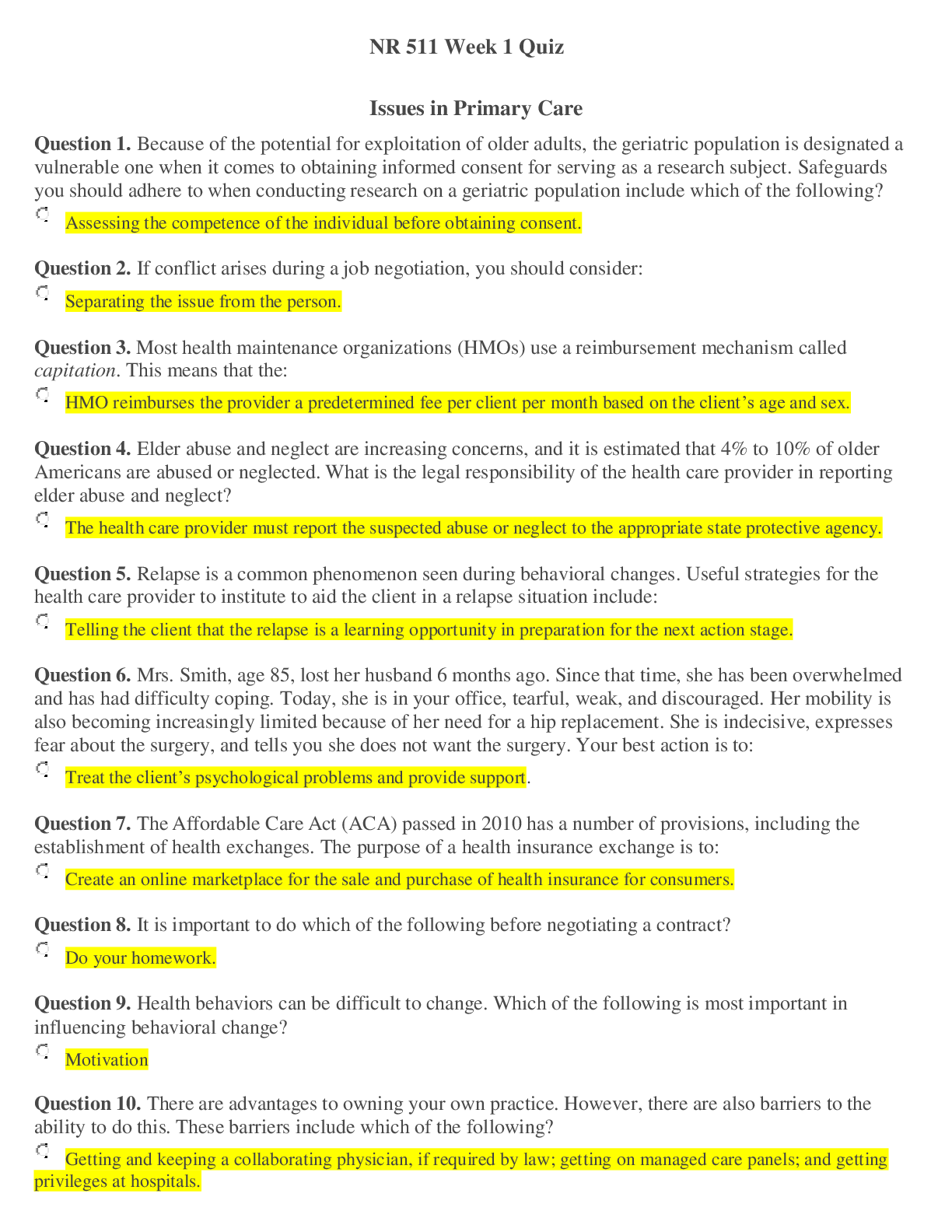
Reviews( 0 )
Document information
Connected school, study & course
About the document
Uploaded On
Jun 24, 2022
Number of pages
14
Written in
Additional information
This document has been written for:
Uploaded
Jun 24, 2022
Downloads
0
Views
76






.png)










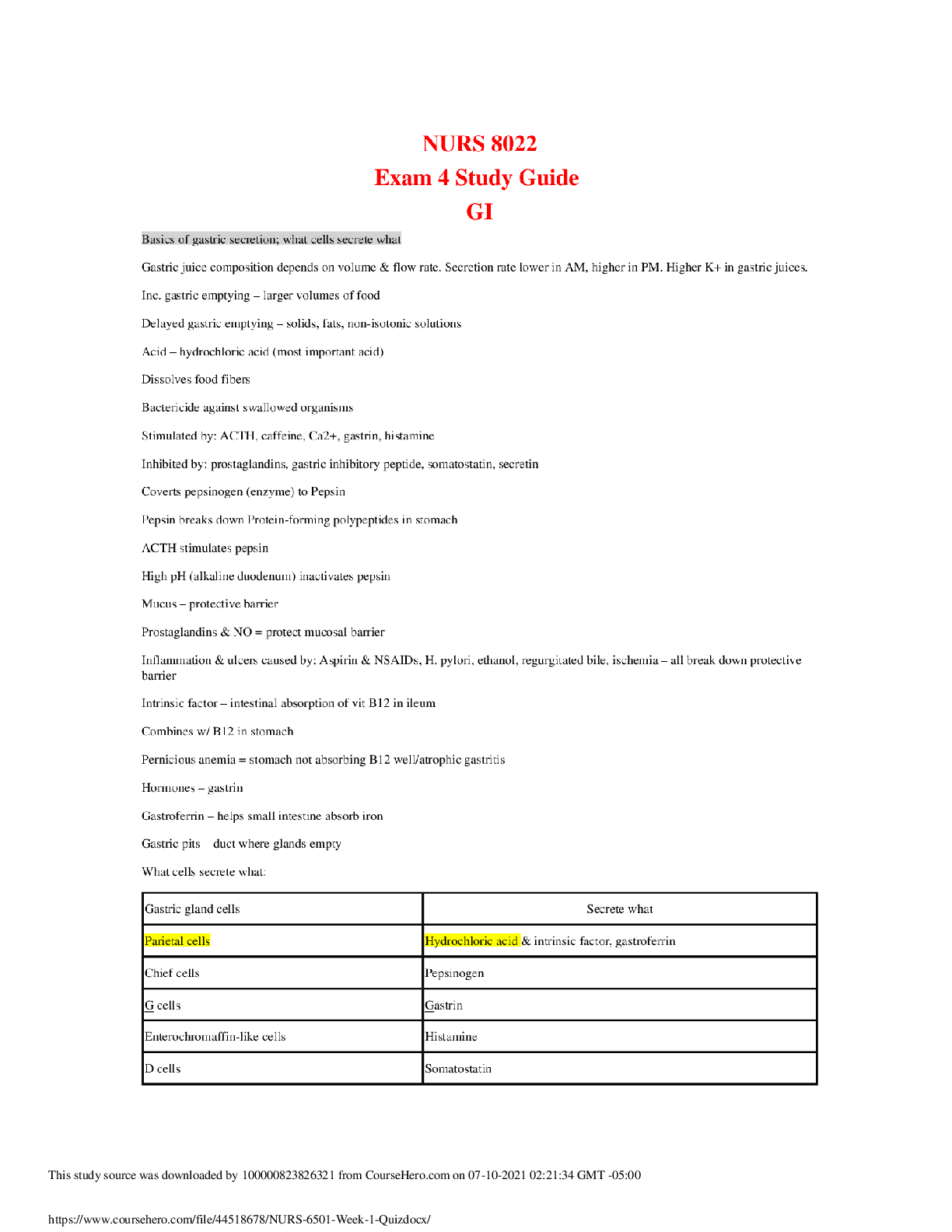
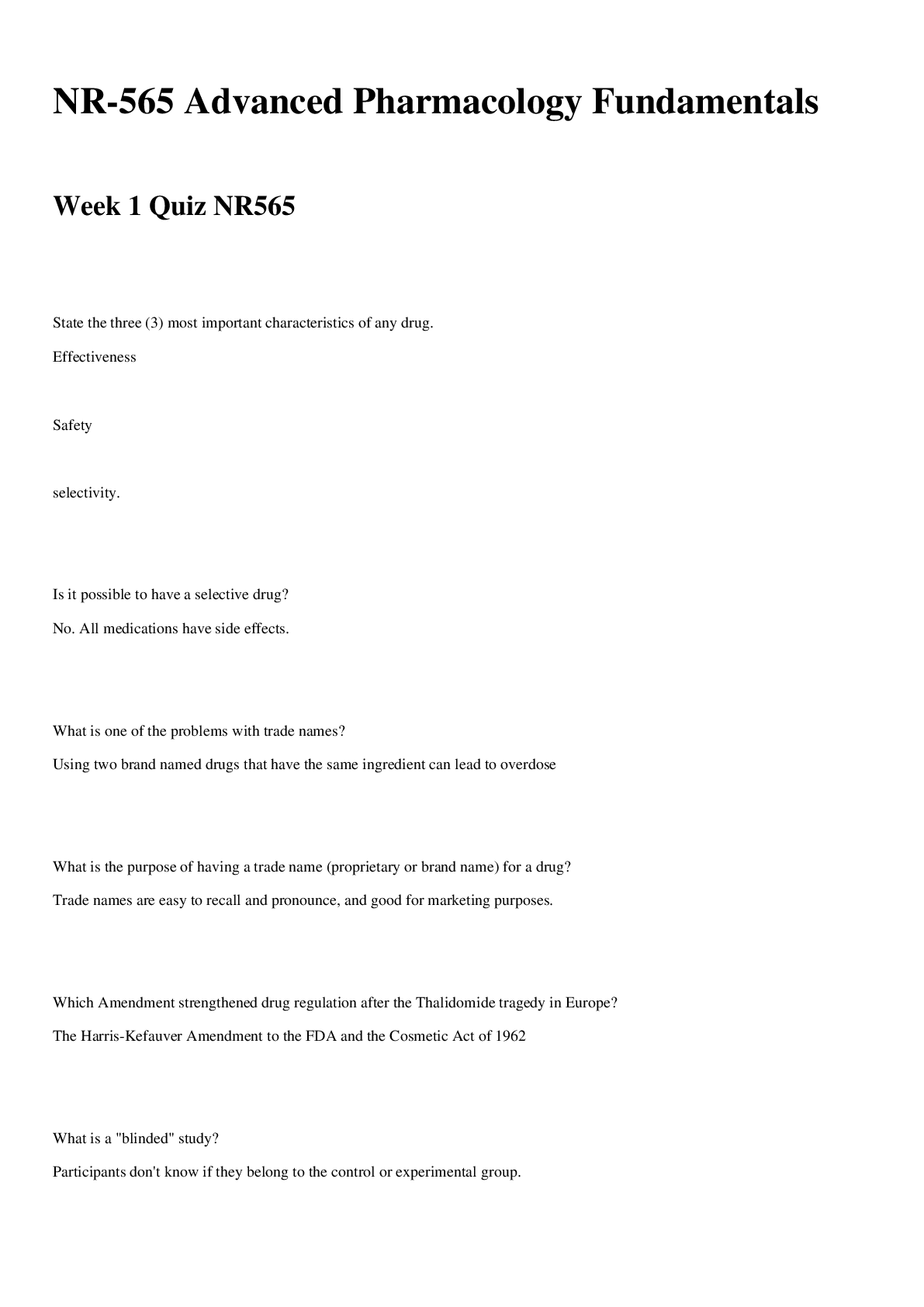
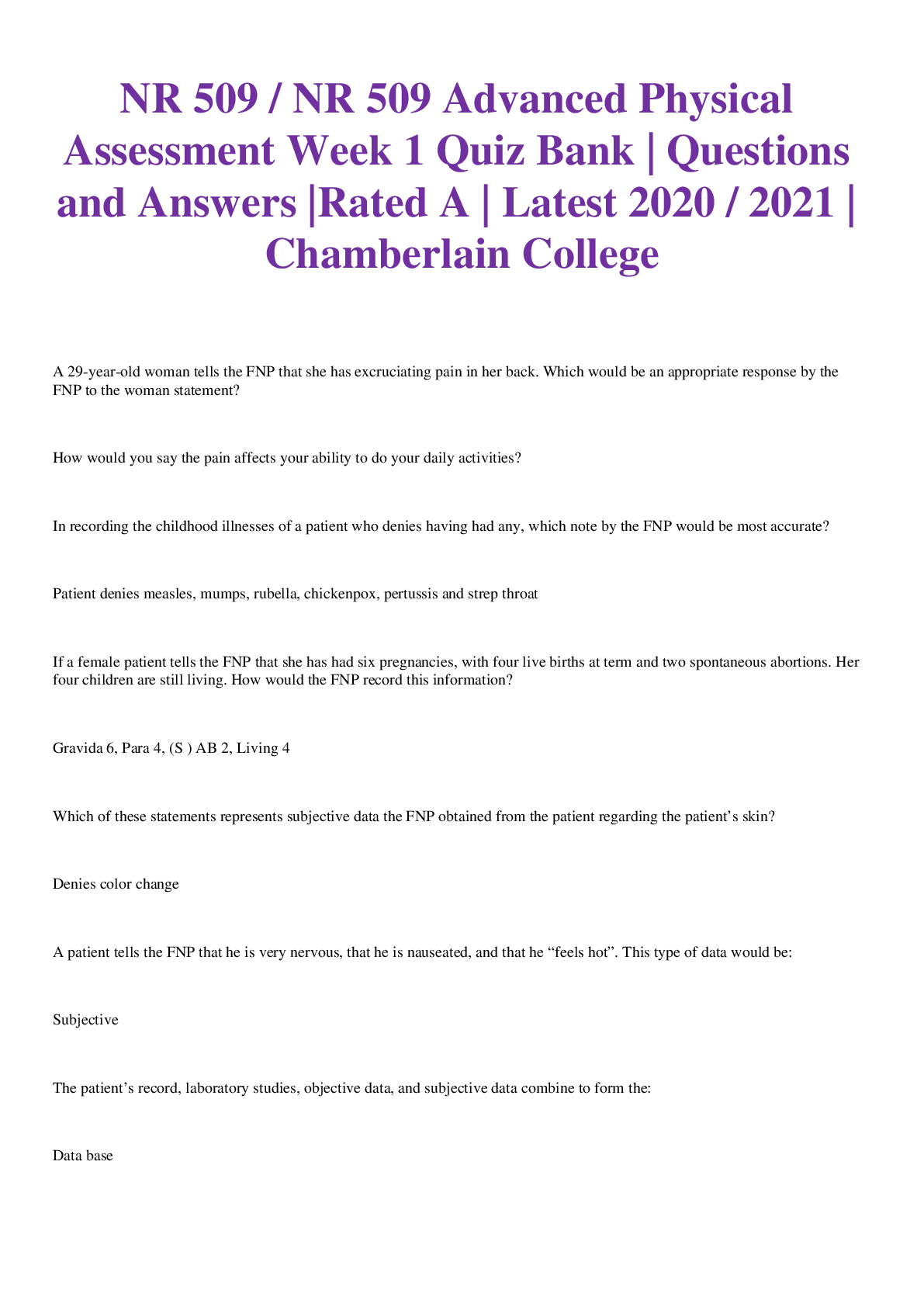
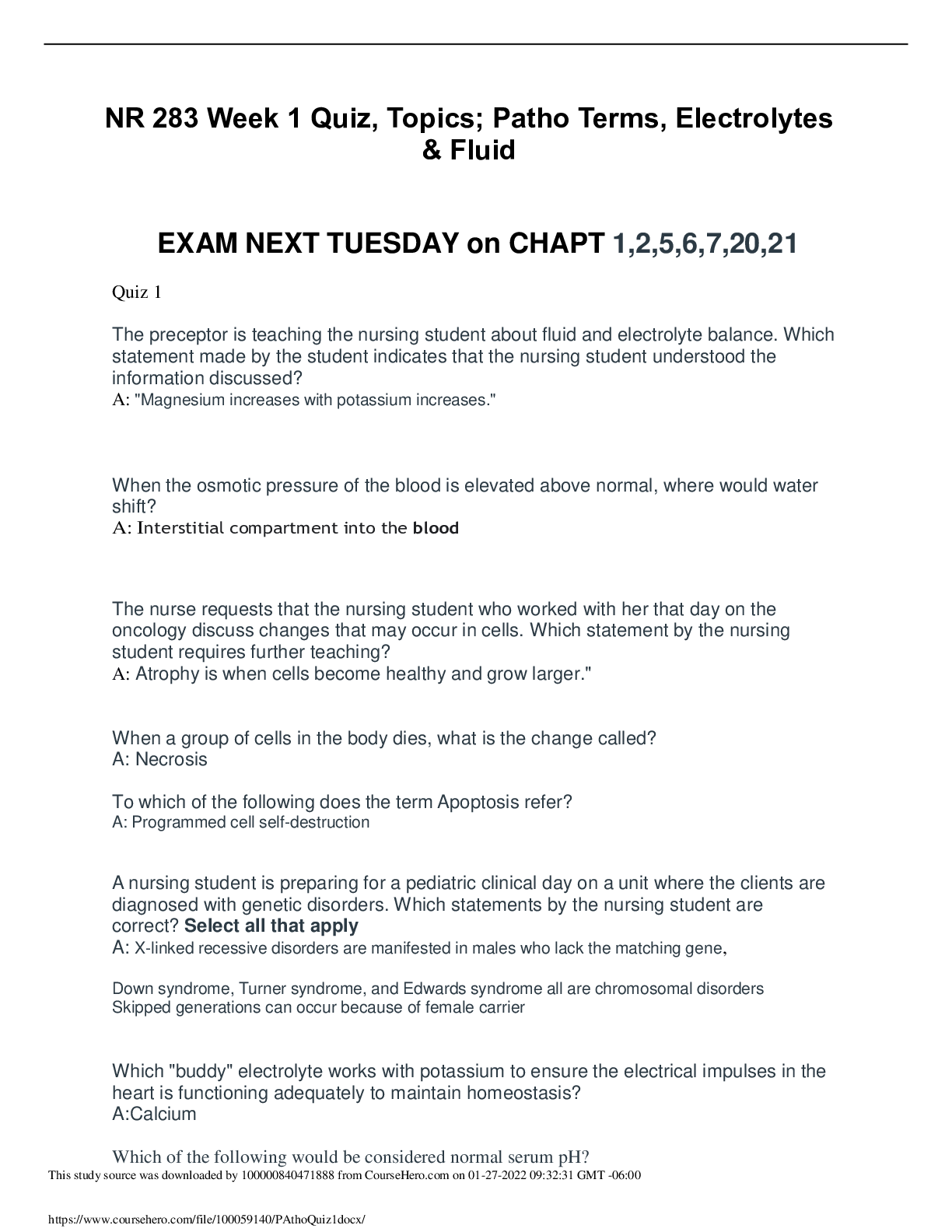
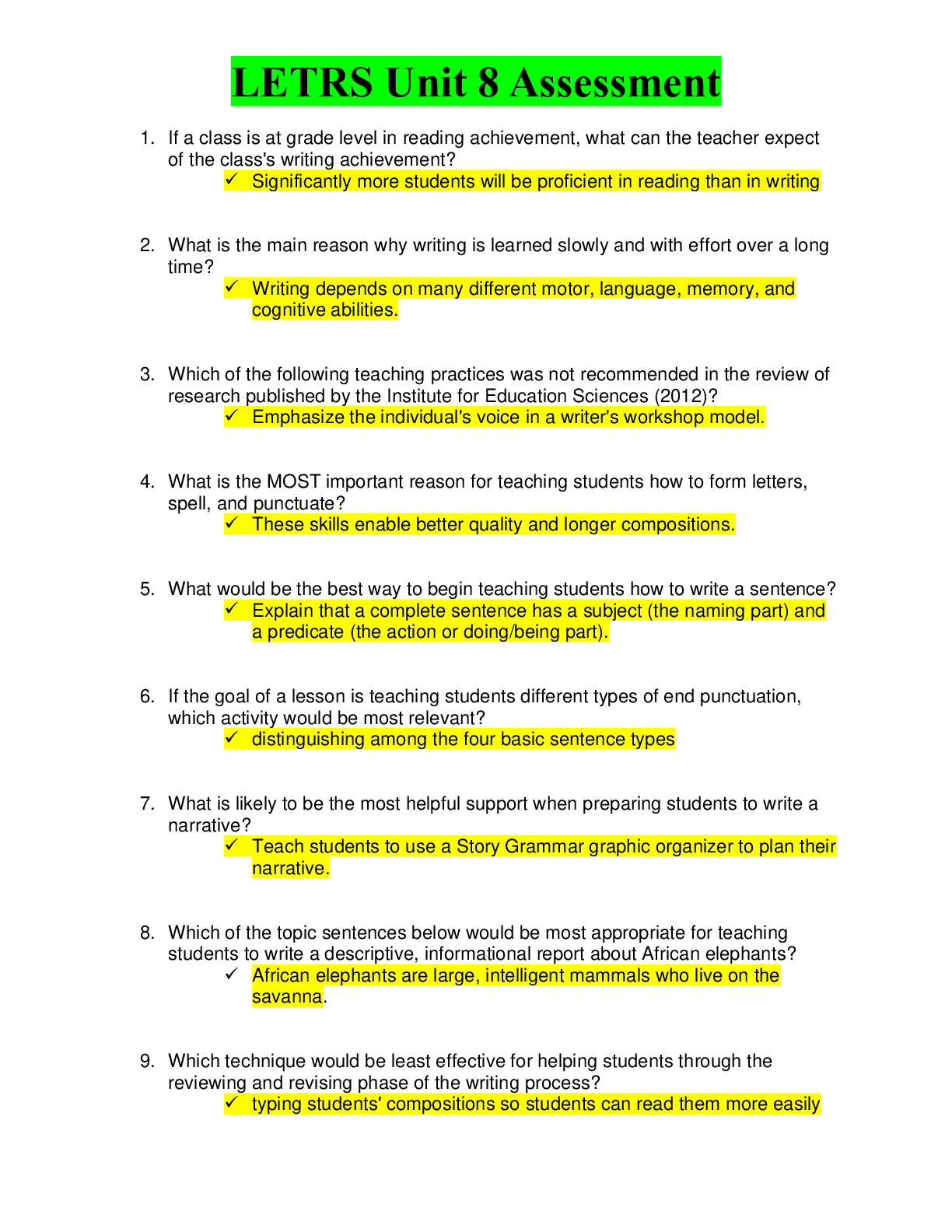
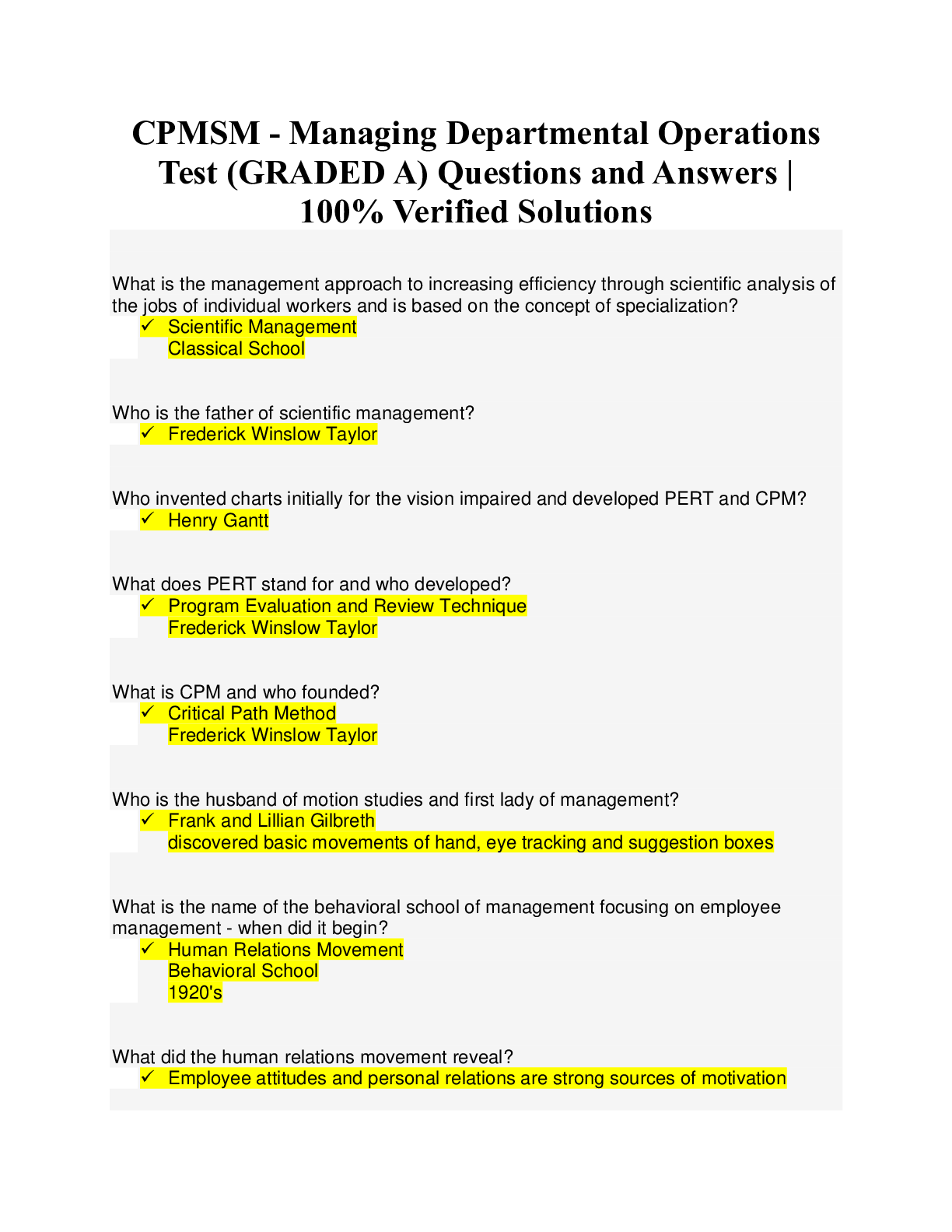
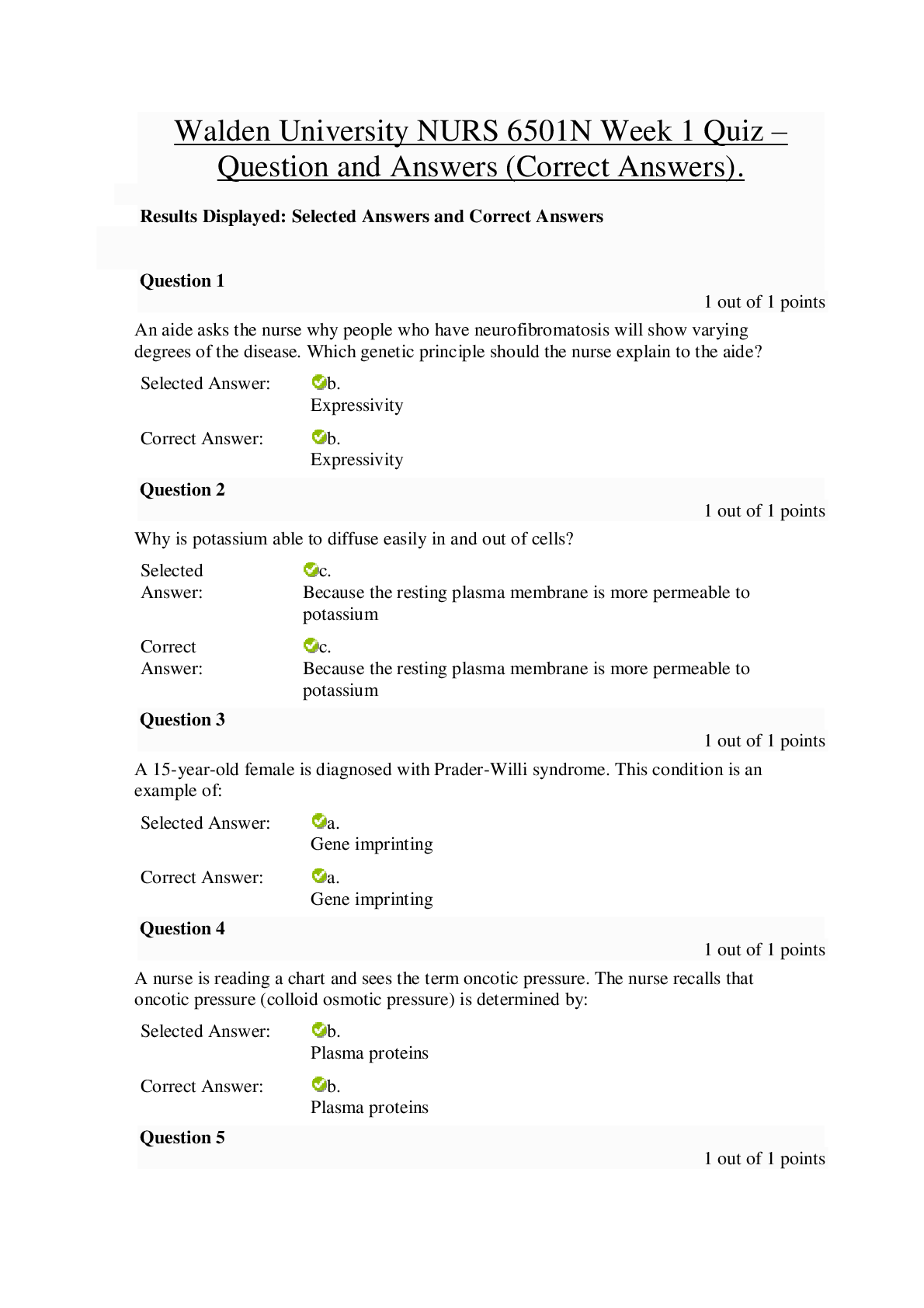
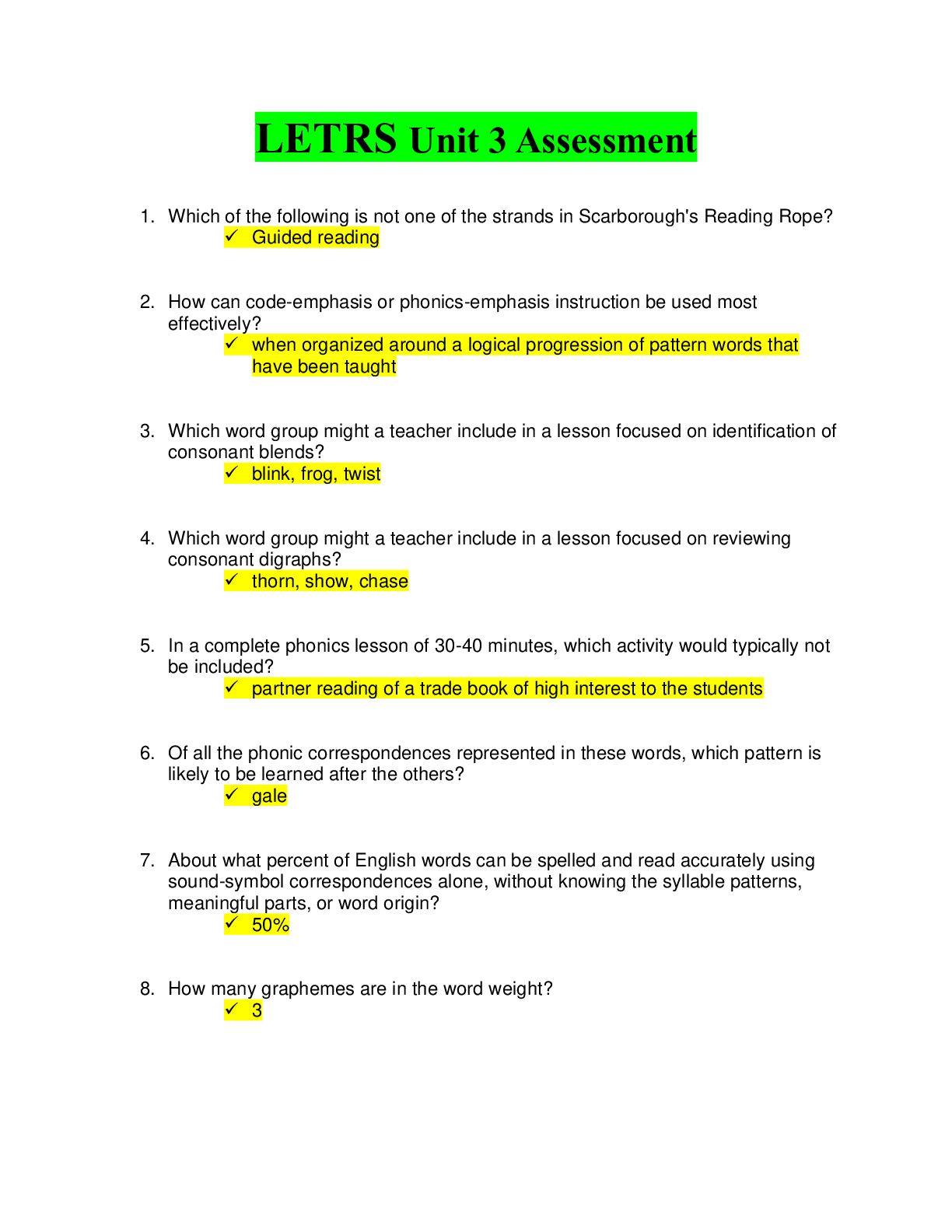

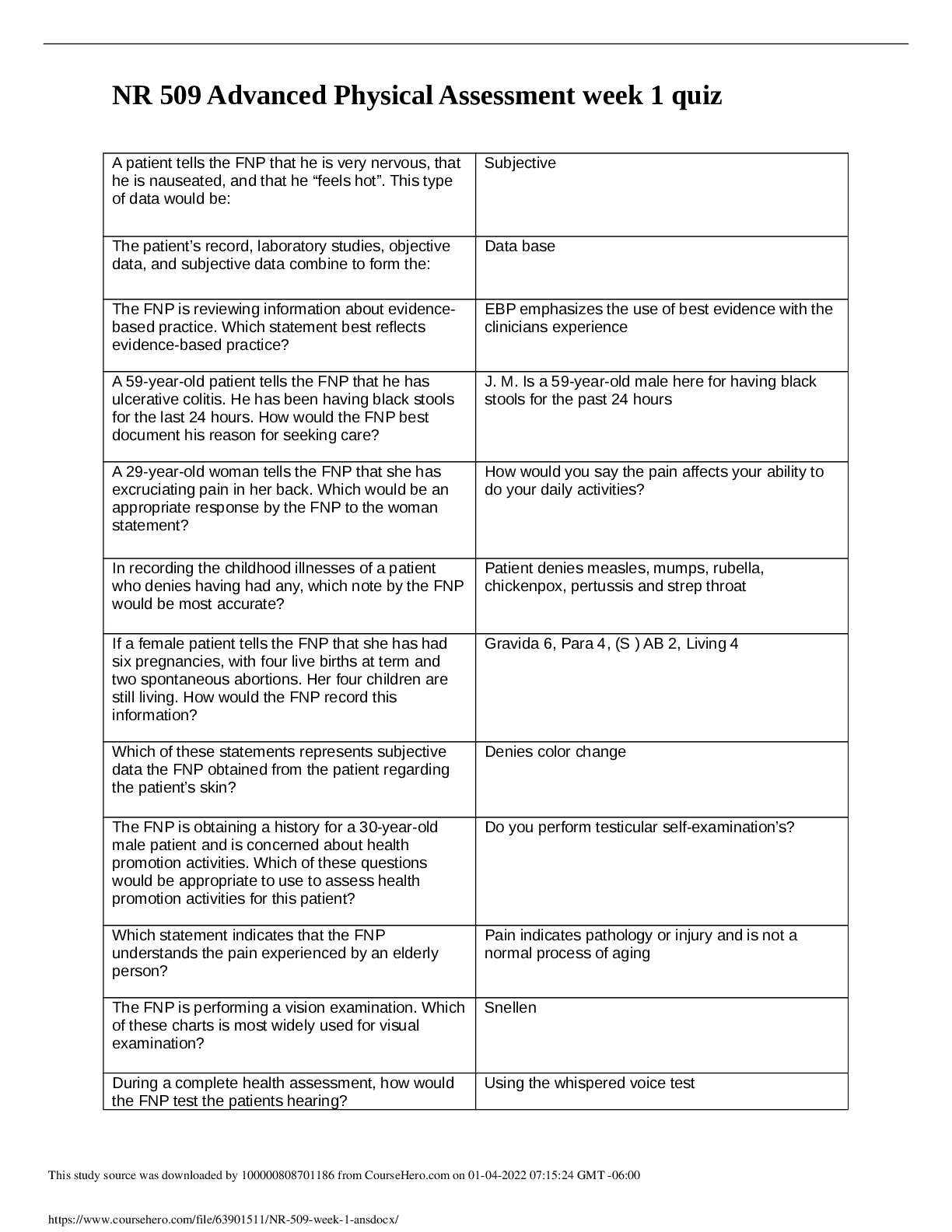
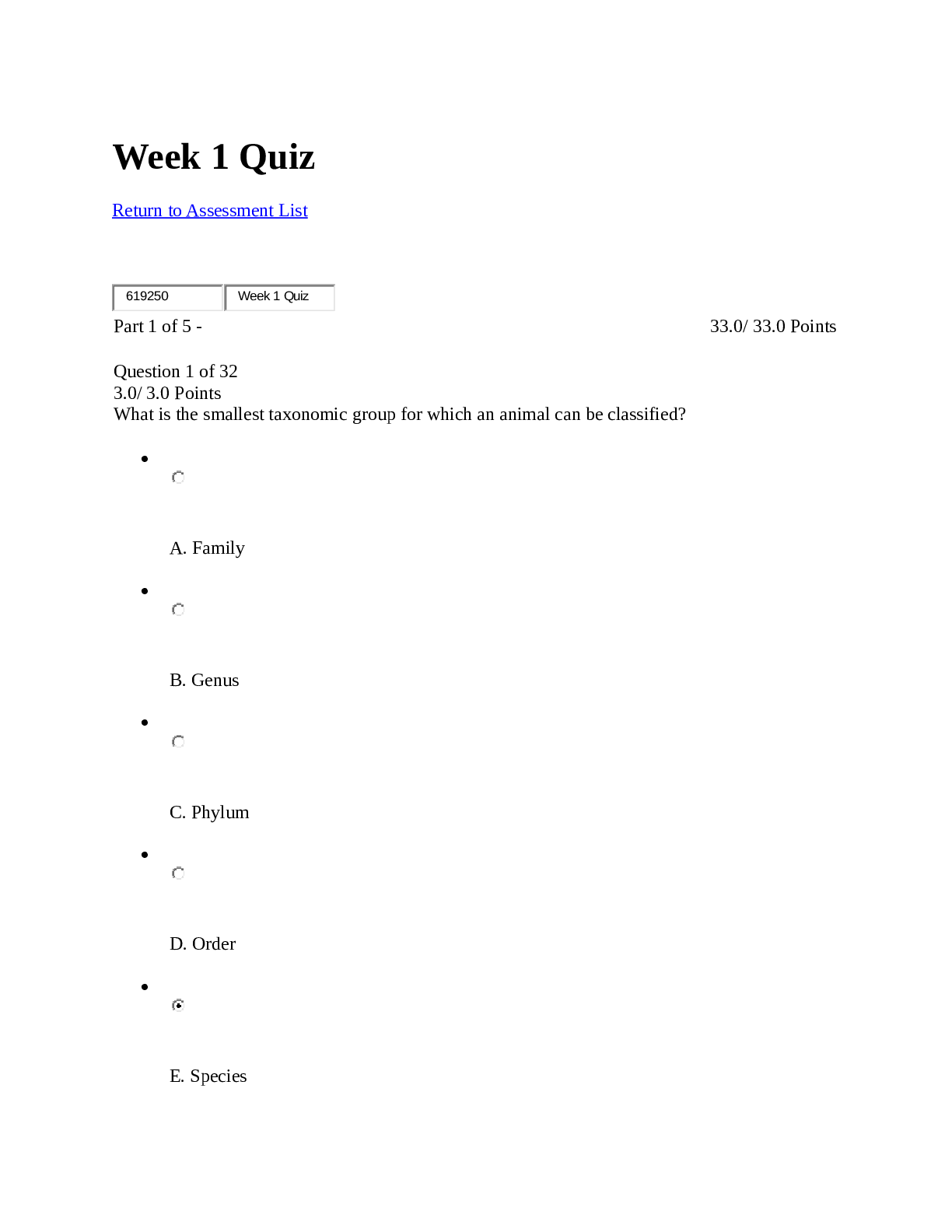
 (1).png)
.png)
